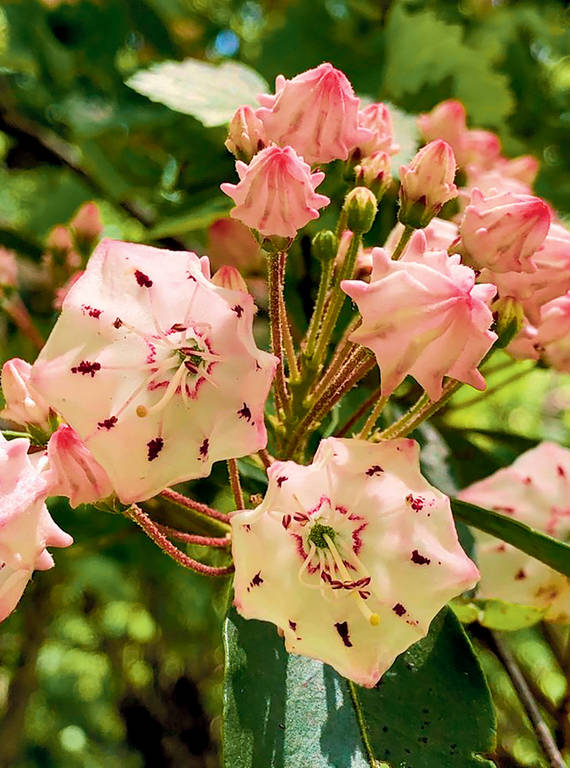Fall 2020
Constancy Amid Chaos
Nature in the time of COVID-19.
I’m writing to you from the past — May 2020 to be precise. At this threshold, with the economy in tatters, more than 350,000 citizens of the world dead of COVID-19, and protesters crowding the streets of cities across the globe in the wake of George Floyd’s death, I wish desperately to know what you all now know about how this story of a crippling disaster and social disruption has played out.
Have we managed to flatten the virus’ curve? Do surgical masks still obscure our otherwise welcoming smiles? Has the Food and Drug Administration approved a vaccine? Has Floyd’s tragic death resulted in meaningful change to policing in our country? Have Americans and their elected leaders mobilized in pursuit of racial justice? Has some sense of normalcy returned to our lives? Or have things only gotten worse?

Throughout his life, the author (at Obed Wild and Scenic River) has sought solace in nature. In some cases, he was drawn into it; in others, he was driven into it.
©BELINDA WOODIEL-BRILLMy wife, Belinda, and I are about as well positioned as anyone to weather a crisis, particularly a highly infectious one: We live on the Cumberland Plateau in rural Morgan County, Tennessee, and occupy a cabin nearly a mile off the blacktop. We’re surrounded by 29 acres of woods, and down the bluff behind the cabin flows Clear Creek, part of Obed Wild and Scenic River, a national park site encompassing the river, adjacent waterways and adjoining trails. Though the roads and trails of our beloved Great Smoky Mountains National Park have been barricaded through much of the spring and conservancy groups have been asking hikers to stay away from the 2,200-mile Appalachian Trail, the footpaths of Obed have continued to beckon to us.
We feel an abiding sense of safety and peace here in our isolated home, and yet we worry — not for ourselves, but for a daughter late in pregnancy with our first grandchild, for parents all well into their 80s, and for the world’s marginalized populations wanting for food, shelter and other essentials amid a global economic collapse. Belinda and I have bestowed a moniker on the fear and anxiety that the current situation inspires, The Beast, and each of us has, on occasion, allowed it to slink into our psyches.
Spring right on cue
I was struck by the jarring contrast between the deadly arrival of COVID-19 and the bounteous awakening of spring, which occurred in the southeastern United States at about the same time, in early March. And I contend there’s a measure of cosmic purpose in the coincident phenomena — one portending loss, the other promising rebirth. In time, one will prove ephemeral, the other, eternal.

This spring, right on cue, wildflowers (such as mountain laurel, above) emerged to bask in May’s sunshine.
NPSThis spring like every other, right on cue, the forest floor bristled with the first emergent spikes of dormant wildflowers and plants, and soon enough the cinnamon and sensitive ferns, bloodroot, wild geraniums, ginger, trilliums, mayapple, foamflowers, spring beauties, and phlox appeared lush and fully formed. And the now-returned hummingbirds hover near the eave where the feeder should be, reminding us that it’s time to mix up a fresh offering of sugar water in welcome.
Pollinators large and small alight on the awaiting blossoms of our blueberry bushes, promising a bounty of fruit later in the summer. In the darkened forest surrounding the cabin, the male whip-poor-wills once again voice their incessant nocturnal come-ons to prospective mates, and we wish them well in their romantic pursuits. Spring thunderstorms rumble through, bestowing on the plants life-sustaining water and inclining Belinda and me to savor the snug shelter of our cabin.
Springtime’s abundant surge of new growth in a time of pandemic suggests not so much nature’s indifference to our plight but rather its blessed constancy in spite of it. Indeed, at a time when so much seems grim and uncertain, spring’s arrival provides the perfect metaphor to buoy spirits and inspire hope.
During my 1979 end-to-end trek of the Appalachian Trail, like all thru-hikers, I was privileged to witness the moment-to-moment changes occurring in the forest over the course of my five-month journey. From watching one season yield to the next, daylight surrender to night, and darkness give way to morning, I discovered that, in the midst of chaos, order and purpose are present for us.
That sanguine observation has sustained me over all the years since my AT adventure, but it seems more relevant now than ever. We humans, like the plants and animals of the forest, are on this journey for the long haul, and months or years hence, though our social norms and economic structures may be irrevocably altered, we as a species shall endure to observe spring’s vibrant — and perennial — spectacle again … and again.
A healing space
Throughout my life, I have sought solace in nature. In some cases (the lure of the AT, for instance), I was drawn into nature’s soothing embrace; in others (instances of personal or professional struggle), I was driven into it. Now, it seems, the latter more often applies, and the promise of comfort for nerves jangled by the cascade of bad news spilling across my computer screen prompts me to lace up my boots and head out into the wilds. The positive effects of entry into nature remain undiminished, but these days, they are not necessarily instantaneous.
Similarly, it took time for nature to work its magic on me all those years ago on the AT. Filled with nagging doubt along the trail’s first difficult miles, I considered quitting. But then, at the instant when it mattered most, an encounter with a fellow thru-hiker — a grieving widow — lent perspective and kept me on the path north toward Maine.
Though I didn’t realize it at the time, I was about to learn the first, and perhaps the most lasting, lesson about life on the trail. Put simply, if one is receptive and open to change, the trail — and in a larger sense, nature itself — seems always to answer one’s questions and meet one’s needs. It sounds mystical, and I wouldn’t believe it if I hadn’t experienced it so many times along my journey.
And I experience it still. Recently, on a warm spring day with bluebird sky, I set out on a familiar trail in Obed, my mind beset with worry: The Beast had slithered into my daypack. But nature, it seemed, wanted nothing to do with my sour mood or its intrusion on an otherwise placid and pristine tract of woods and so was about to meet my needs once again.
As I took up the trail, a great horned owl, in rare defiance of its nocturnal wont, swooped low across the footway and roosted in a nearby tree. I stood stock-still, heart a-thumping, and watched it in wonder for a full 10 minutes before those enormous wings carried it to another roost deeper in the forest. The Beast, no match for the owl’s powerful talons or potent symbolism, was long gone.
Social distancing al fresco
Though the hike occurred on a Monday, the trailhead parking lot was full of cars bearing license plates from distant counties and states. While Obed’s visitor center was closed, the park — which naturally encourages parties to disperse — had remained open (unlike many national and state parks), and it had become something of a mecca for locked-down hikers eager to stretch their legs. I shared the path with dozens of other foot-travelers and half that many dogs.
Yes, the rules of social distancing still applied, and we all courteously pulled off the trail to let others pass, but the ubiquitous surgical masks were absent, and almost every person I met offered a warm greeting and wore a contented smile. My encounters on the trail contrasted starkly with my experience on weekly forays to a crowded grocery store, where worried eyes peering out from above fabric face coverings telegraph anxiety and eagerness to clear self-checkout and return home.
The trail induced the opposite inclination, and along the way I saw people lolling on sun-drenched rocks, bending to snap photos of flowering plants or dangling bare feet in the cool water of the creek. It seems that in these troubled times, my fellow hikers and I were less intent on an aerobic, endorphin-inducing dash through the woods than on a soothing immersion in them. The Japanese have a name for such quiet engagement with nature: forest bathing, “shinrin-yoku.”

National Parks
You can read this and other stories about history, nature, culture, art, conservation, travel, science and more in National Parks magazine. Your tax-deductible membership donation of $25 or more entitles…
See more ›A hike that normally takes me just over an hour occupied me for four, and I found myself captivated by features of the trail that I had passed by dozens of times without really noticing them: the spreading carpet of ancient lycopodium, the green-blue water of the river lapping the edges of huge boulders, the clusters of delicate bluets that had survived February’s frost to bask in May’s warm sunshine, the lush explosion of cream-white mountain laurel blossoms accented with delicate pink striations. By the time I arrived back at the car, my forest bath had washed me clean, and my reserves of optimism had been fully recharged. I’m comforted to know that if and when The Beast returns, its exorcism and my cleansing await at the nearest trailhead.
From the past, a message of hope
By the time you read this essay, the cycling of seasons will have carried us past spring, through summer, and into fall.
From my springtime vantage point, I’m picturing squirrels scurrying for fallen acorns beneath oak trees washed in reds and golds. I’m imagining the welcome nip of crisp mountain mornings that occasion the reach for a wool sweater. And I’m envisioning the trails of our national parks teeming with life — the wild denizens of the forest joined by footloose trekkers bearing the burden of their backpacks, but little else.
That is my hope. But, if COVID-19 is still cutting a deadly path across the world, and humans continue to peer from a troubled present toward an uncertain future, they can be assured of this: In time, spring’s promise of awakening and renewal will, yet again, be fulfilled.
About the author
-
 David Brill
David BrillDavid Brill’s writing has appeared in dozens of publications, and he is the author of five nonfiction books including “Into the Mist: Tales of Death and Disaster, Mishaps and Misdeeds, Misfortune and Mayhem in Great Smoky Mountains National Park” and “As Far as the Eye Can See: Reflections of an Appalachian Trail Hiker,” now in its eighth (30th anniversary) printing.


